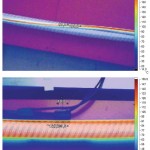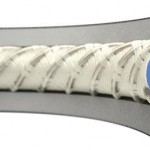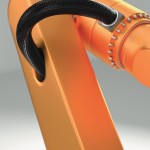Many substances require supplementary heat for transport. The usage of electrical heat in flexible hoses is also a significant challenge in applications for hazardous areas. The templine heated hoses available from Masterflex represent an alternative concept, in which a minimum of four heating conductors cover the medium carrying hose in a way to ensure optimal heat transfer.
The author: Hans-Jürgen Günzing Production Manager, Masterflex
Industrial heating systems for tracing are represented by heating tapes and series-resistive heating cables designed for extreme operating conditions. On surfaces of tanks and pipelines, process conditions require highly protected and electrically reliable heaters to support long process life time. As an alternative to electricity steam can be transported in two-wall pipes or in accompanying small pipes joined to medium pipes. Heat transfer quality in those solu-tions depend to a large extent on the continuity of the steam supply, the occurrence of leakages and the quality/condition of the thermal insulation.
Manufacturers of conventional heated hoses are also active in heat tracing business. Here we find two alternative systems:
- Series-resistive heating cables with metallic heating strand: the conductor comprises of resistance alloys where heat production is based on current and resistance of alloy. Heat emission is independent from ambient conditions.
- Heating tapes with a semi-conductive heating element: the core is manufactured of a plastic/carbon black mixture reacting on an increase or decrease of ambient temperature by acceleration or drop of heat output. This accords to a specific and predefined process (PTC characteristic).
Developers of electrical heating systems are confronted with various challenges linked to the laws of physics. Plastics are electrical and thermal insulators. Their heat transfer resistance increases along with the material thickness around the heating conductor. Additional energy (heat) is required to transcend this barrier for achieving anticipated process conditions.
A second important aspect is the heat that is propagated from the heating cable or tape to the heated surface. The smaller the contact surface between the heater and the hose, the less efficient is the heating system. This again requires additional load to compensate and possibly an extra heating cable or tape to minimise temperature variations on hose surface.
The picture of a thermal imaging camera opposite shows the typical heat expansion of a conventional heating cable or tape on a pipeline.
Whereas the red area in the centre indicates high temperatures, the values drop rapidly towards the edges (blue).
In the case of heating tapes with a semi-conductive heating element, the heat concentration leads to an automatic load reduction and results in an ineffective heater performance. Compensation can be the installation of more cable or tape runs. However, the investment costs increase and the solution drives to degration compared to alternative concepts.
High bending and free moving space
A study of various heated hose designs reveals the need of a high level of tensile strength and pressure resistance paired with bending and torsion strength. These properties should not be interfered with by the assembly of a heating tape or cable. Heating tapes and cables assembled on a hose surface, spiralled or straight/parallel, reduce bending flexibility. Heating tapes do not follow minor bending or torsion. Furthermore, contact for heat spread can go lost to surface heated. Result: Reduced or lost heat transfer.
Winding an industrial heating cable with series-resistive performance around a hose represents a compromise. Here again the quality of heat transfer is influenced by several plastic layers between the conductor and the hose. This fact is offset by an increased load and a higher surface temperature of the heating conductor, resulting in lower specific loads and operating temperatures. The limit is determined by the maximum operating temperature of the hose components.
Hose installations in hazardous areas require specific attention to heat propagation and hot spots (punctual overheating caused by low heat transfer). Both factors need to be taken in consideration together with the ignition temperature rating and energy. High heating element or conductor temperatures restrict opportunities for employment in this specific area.
Bending-friendly hose concept
A new heated hose design from Masterflex can be able to deliver the answer to all questions. The core of the templine heated hose system is a flexible hose combined with temperature-resistive braid. The yarn used combines high abrasion resistance with tensile strength and compression resistivity. The circumferential braid supports bending flexibility about 360° with 180° bending angles. Four heating conductors perpendicular to each other are incorporated in the braiding. Their positions create a helix of four heating conductors. The hose acts as a spiral spring that prevents kinks or conductor breaks caused by overexpansion or compression. Even under extreme conditions like permanent tension, pressure or torsion (automation robotics), the service life is increased compared to conventional systems.
This enhanced performance finds its confir-mation in test reports of independent institutes, where hoses with inside diameters between 4 and 25 mm have withstood more than one million bending turns.
The spiry embedded heating conductor ensures almost entire contact with the hose surface and initiates homogeneous heat – a result of the braid design, yarn quality and method of conductor embedding (low heat transfer resistance).
The combination of a metallic heating conductor and an in-house developed temperature controller represents an ideal combination to achieve the required media temperature in close tolerances. An important criterion for conveyed temperature-sensitive liquids, gases and pellets. Even the assembled heated hose can be rearranged to change the basic load value by changing the heating conductor connections (50 to 200 %) together with taking in account specific material limits. Figure 1 (bottom) shows the thermal performance of a heater operating without thermal insulation or a protective outer braid.
A direct comparison between conventionally heated hoses and the templine heated hose system reveals the increase of energy efficiency by max. 30 %. Hot spots can lead to dangerous operating conditions inside hazardous areas. Owing to the system concept and the optimised engineering design, the templine heated hose reduces this risk to a minimum.
Online-Info: www.cpp-net.com/2111440
Features of the system
At a glance
- hose diameter: 4, 6, 8, 10, 12, 14, 16, 20 and 25 mm
- two product series type I: operating temperature max. +80°C type II: operating temperature up to +200 °C
- operating voltage: up to 230 V
- minimum 4 heating conductors, fluoropolymere insulation
- protective class I, safety class IP 65
- hose fitting acc. to international stand-ards (mild steel, stainless steel)
- templine configurations: external supply (no controller) / system specific temperature controller / temperature limiter / temperature control-ler / temperature limiter assembled in terminal enclosure
Share:











